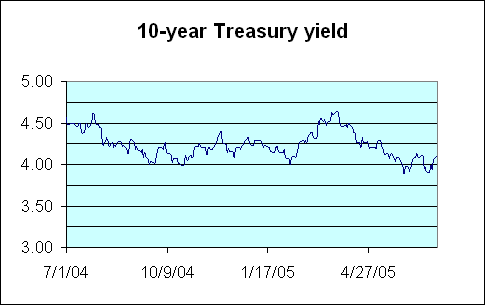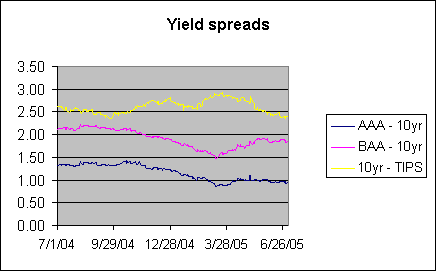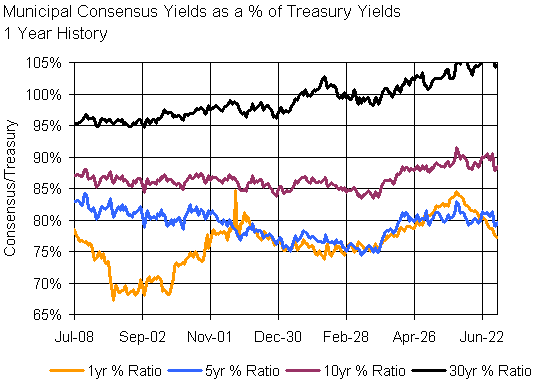Sherlock Holmes solved one of his cases by noticing a dog that didn’t bark. Well, here are a
few canines that don’t seem to be yipping around the decline in long-term bond yields.

As shown in the graph on the right, the yield on 10-year Treasury bonds has declined
50 basis points since last March. Fed Chairman Alan Greenspan
offered
this analysis last month of the role that foreign purchases of U.S. bonds might have played
in the decline in long-term yields:
The heavy accumulation of U.S. Treasury obligations by foreign monetary authorities is yet
another hypothesis that has been offered. And, doubtless, those purchases have lowered long-term
U.S. Treasury rates. But, given the depth of the market for long-term Treasury instruments, the
Federal Reserve Board staff estimates that the effect of foreign official purchases has been
modest. Furthermore, such purchases seem an implausible explanation of why yields on long-term
non-U.S. sovereign debt instruments are so low.
Since the foreign purchases theory continues to have advocates (most recently, Stefan Karlsson at the von Mises Institute and some
of the very well-informed readers commenting on my earlier post), I
decided to take another look at this explanation.

Section 5 of the Treasury Bulletin
records the volume of net foreign purchases of long-term U.S. Treasury bonds and notes. These
went from $277 billion in 2003 to $352 billion in 2004, and $101 billion already in the first
quarter of 2005. In a thin market with significant risk and private information, one certainly
might expect a change in the volume of purchases to alter the yield relative to other assets.
Of course, the Treasury market is a very dense, low-risk, public market, so it’s quite possible
that huge volume changes could be absorbed with little change in yield. Whether the volume of
foreign purchases that we’ve seen could be sufficient to account for a significant part of the
change in the spread between long- and short-term Treasuries would seem to be an empirical
question.
If increased foreign purchase of long-term Treasuries is the explanation, I would have
expected to see its effects also show up in a couple of other spreads. The bottom blue line on
the graph on the left tracks the difference in yields between Aaa-rated corporate debt and
10-year Treasuries. This spread has barely inched up over the last four months, meaning that if
one were to blame the lower yield on long-term Treasuries on foreign investors, one would have
to hypothesize that they bought Aaa corporate debt in similar quantities. On the other hand,
the magenta line shows that the Baa-Treasury spread has risen about 35 basis points since March.
So if you said foreigners were buying long-term Treasuries and Aaa corporate but not Baa
corporate, you might claim to have explained more than half of the decline in the Treasury yield
over the last four months.

|
Another place one could look for evidence that the declining yield on long-term Treasuries
might be attributed to foreign purchases is the spread between Treasuries and municipal bonds,
since the latter yield tax benefits to U.S. residents but not foreigners. The maroon curve in
the graph at the right confirms that 10-year Treasuries have indeed fallen about 20 basis points
since March relative to munis of the same maturity.
A final spread that seems worth consulting is that between 10-year Treasuries and the 10-year
Treasury Inflation-Protected Security maturing in 2013, which spread is given by the yellow line
in the left-hand graph above. This spread, which corresponds to investors’ expectations of
inflation, has dropped nearly 50 basis points since March.
There thus seem to be plenty of attractive explanations for the decline in long-term
Treasury yields over the last four months. One might be able to attribute up to half of the
decline to foreign purchases, or try to pin the whole thing on decreasing inflation expectations.
So why aren’t Greenspan and others convinced? The problem is that when you look at the
behavior of each of the above graphs for the past year as a whole (July 2004 to July 2005)
rather than just since March, everything goes in the wrong direction. In particular, compared
to a year ago, the 10-year Treasury yield has still fallen by 50 basis points, but this is
almost the same as the fall in the TIPS yield since July 2004, meaning you can’t attribute any
of the year-to-year decline in the nominal 10-year yield to lower inflation expectations. The
Baa yield has fallen even more than Treasuries since a year ago, so if the decline in Treasuries
is to be attributed to foreign buying, foreigners must have been purchasing even more of the
corporate debt. Same story from the munis– very little year-to-year decline in the spread
between 10-year Treasuries and municipal bonds.
So if, on a year-to-year basis, neither the inflation terrier nor the foreign-purchasing
poodle are yapping, what are we left with? It seems to me you then have to attribute much of
the year-to-year decline in long-term yields to a decline in the term premium itself. And as my
research with Dong Heon Kim has
shown, this is exactly the sort of thing that can often be an early signal of an economic
downturn.
Calculated
Risk has noted that, once you subtract recent inflation, the current fed funds rate is near
zero in real terms when the CPI is used to measure inflation, though it would be about 1% if you
used core inflation. And Macroblog argues
that, if the Fed does not raise rates much further it might be able to replicate the 1994-95
soft landing. Both observations have merit, but neither line of reasoning would give me much
comfort if the Fed were to push rates up by more than another 50 basis points. I’m therefore
disturbed that
option prices suggest the market believes there’s a 10% probability the Fed could go all the
way to a 4.0% fed funds rate by October. Unless the long yield rises significantly before then,
I would strongly caution against that. My recommendation continues to be that Mr. Greenspan
should think of an inverted yield curve as a big red stop sign. If he just speeds past it, some
dogs might really start howling.
A thoughtful post about an important subject. One question: doesn’t the degree of substitutability between different types of bonds matter greatly to any exercise in which we try to draw inferences about the cause of the “conundrum” from bond yield differentials?
For example, in the case of Greenspan’s logic (in which he discounted the imporance of foreign CB bond purchases because yields of non-US government bonds have also fallen), couldn’t it be the case that foreign CBs are indeed driving down treasury yields, but that private bond purchasers are therefore moving to non-US bonds to chase higher yields?
Similarly, it seems possible to me that the spread between AAA and US govt bond yields has not risen because as foreign CB purchases of US govt bonds have driven down treasury yields, private investors have migrated into AAA bonds as they chase higher yields. If those two types of assets are highly substitutable to private investors, the lack of a growing AAA-treasury yield gap could be hiding the fact that there may still be a foreign CB effect on treasury yields.
I’m not trying to argue that foreign CBs are the only, or even principle culprit behind the conundrum — simply that I think it might be difficult to tell based purely on yield spreads. However, ultimately the question is, as you say, an empirical one.
Good point, Kash. But I would have expected the substitutability between Treasuries of different maturities to be greater than the substitutability between Treasuries and Baa corporate or munis.
JH — One point. The Committee always takes pains to point out that their statements are conditional on a particular view of how the economy will unfold. (Santomero was explicit about this in his comments yesterday.) That view, of course, includes some belief about the trajectory of long-term interest rates. What we don’t know at this point is whether statements that seem to suggest a continuation of funds rate hikes — such as Lacker’s and Santomero’s comments this week — actually envision a complete flattening or inversion of the yield curve. That would be interesting to know.
FWIW regarding all this, something that I’ve seen mentioned only by Arnold Kling is JP Morgan’s analysis that the “savings glut” is largely corporate savings…
“in the period from 2000 to 2004, corporate savings in the G6 economies increased by $1,091 billion (2.7% of global GDP)”
… this after corporate savings had declined by $730 billion over the four years before that, 1996 to 2000 — producing a $1.8 trillion swing in corporate savings in just the G6.
Corporations boosting saving like that rather than spending would seem to affect demand, something the Morgan piece goes into.
http://pull.jpmorgan-research.com/cgi-bin/pull/DocPull/30969-AFE3/95584298/Global_Savings_GIut.pdf
I’m completely baffled by the muni spreads. Munis are hardly riskier than Treasuries (I think years go by without a single default). Why are their spreads so narrow? Are high bracket investors finding enough room in the 401Ks, or buying I bonds instead?
Jim:
I am also curious about the “identity” of our mystery savers. And suspect that the Asian CBs are being scapegoated a bit.
There’s got to be a huge pool of labor arbitrage gains for the multinationals who are partners in the offshoring process to match the big reserves the Asian CBs have piled up.
Thanks for the link to the JPMorgan doc.
Should we be worried by low bond yields?
Alan Greenspan calls it a ‘conundrum’, and at least some econobloggers are worried about long bond yields – and the yield spread – being so low despite higher Fed rates and a relatively buoyant US economy. James Hamilton is worried we could see an inve…
The only puzzle is why any economist believes that the Fed couldn’t drive down long-term rates if it wanted to badly enough.
Even if the Fed found itself not possessing any long-term bonds, it could either issue its own long-term securities, or ask Congress for the power to do so. With Fed-issued long-term securities, the money taken out of the economy with every sale would not be put back into the economy. Long-term interest rates would rise as the supply of long-term debt instruments increases relative to demand.
Well, now they are going up and you are posting on that.